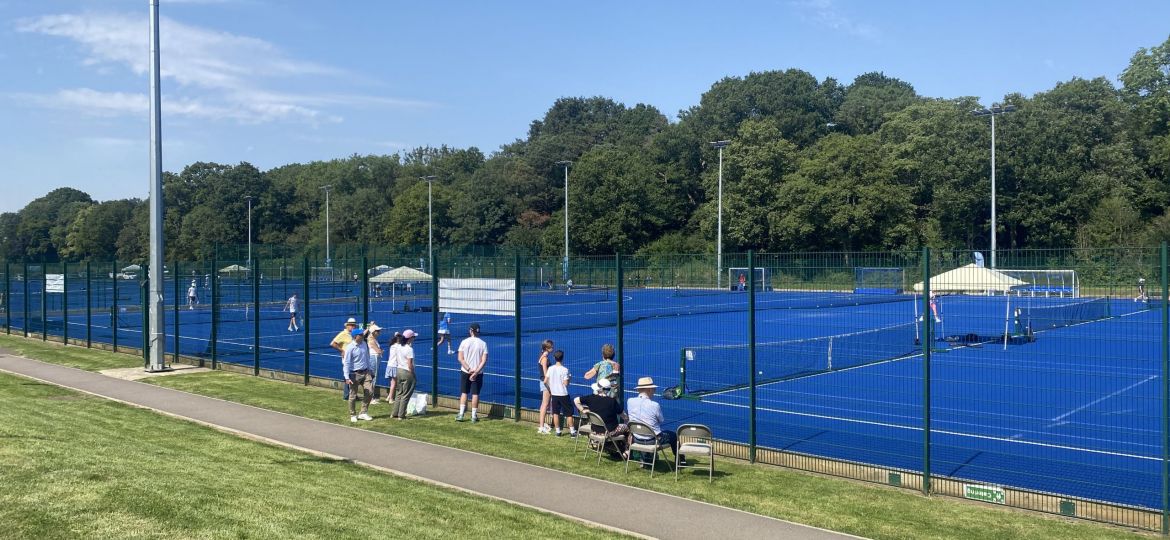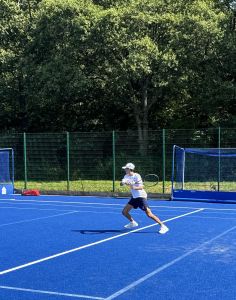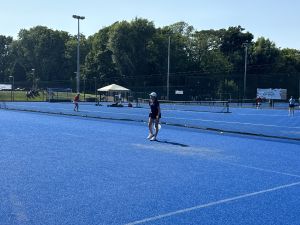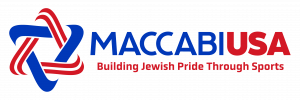
Written By By Nate Bilgoray
Surprise!
Blue courts?
What’s this turf?
Which lines are what?
When the EYMG tennis competition began, the players had to adjust to a unique playing surface. Look down, and you’d think you’re at Boise State’s football stadium. Look up and see the procession of airplanes, albeit small, above, and you’d think you’re at the US Open.
 Maccabi Great Britain exhausted all options to find a place able to provide the 18 tennis courts needed for this year’s competition. After contacting 15 prior venues, it settled for a place with a field hockey pitch large enough to be converted into an array of tennis courts – with the understanding that it was “not necessarily the perfect tennis court,” said Stephen Joseph, the head of tennis for Maccabi Great Britain.
Maccabi Great Britain exhausted all options to find a place able to provide the 18 tennis courts needed for this year’s competition. After contacting 15 prior venues, it settled for a place with a field hockey pitch large enough to be converted into an array of tennis courts – with the understanding that it was “not necessarily the perfect tennis court,” said Stephen Joseph, the head of tennis for Maccabi Great Britain.
The makeshift courts feature a deep blue turf like the famous field at the Boise State football stadium, affectionately known as “Smurf Turf.” However, the conversion left competitors facing some challenges.
 The tennis lines were faded, but the field hockey lines weren’t, making things tough for the athletes, who also serve as the referees. At the youth tennis level, players are used to making their own calls. But in this situation, self-officiating brought new adjustments.
The tennis lines were faded, but the field hockey lines weren’t, making things tough for the athletes, who also serve as the referees. At the youth tennis level, players are used to making their own calls. But in this situation, self-officiating brought new adjustments.
“It’s annoying when you hit something that’s in, and it’s just convenient enough for them to say it isn’t,” Maccabi USA U16 player Eli Gill said.
A bright white field hockey line ran across some of the courts.
“There’s a white line, but it’s not the baseline. It can be confusing,” USA coach Hadas Ronen Vazquez said. “It should bring some bad calls obviously – I did see some.”
Faded lines and questionable calls weren’t the only road bumps posed by the blue turf. The surface itself, which resembled astrosturf, was a challenge. Maccabi USA U16 player Jerry Flombaum said he expected to play on “normal grass,” and USA U18 player Eric Davis was looking forward to it.
“I was excited to play on grass because I’ve never played on it before,” Davis said.
Normal grass is soft, but if you’ve ever played turf, then the term “turf burn” may sound familiar. If it does, then you know that this surface can be tough on your skin, as Davis discovered.
“The ball doesn’t bounce as well [on turf], so I slid reaching for a ball and my knee scraped on the ground,” Davis said. “It was bothering me, taking some of my focus away from the actual match.”
“It’s very fast, and the ball goes very low, very fast,” Vazquez said. “I’ve never played on grass, but it feels like maybe grass. I expected [some kind of] turf, but I didn’t expect something like this.”
Bottom line, it was this or nothing.
“We had to accept the fact that it was either that or not run a tennis tournament, and we wanted to run one,” Joseph said. “There was nowhere else in the area that made sense.”
Nate Bilgoray is a sophomore at the University of Florida studying journalism and sports media. With ambitions to be the play-by-play voice of the UFC, Nate is honored to continue his journey to doing so with Maccabi Media. Covering the next generation of Jewish athletes, learning from great Jewish mentors all while experiencing the European Youth Games is a dream come true for Nate. Connect with Nate on LinkedIn here.
